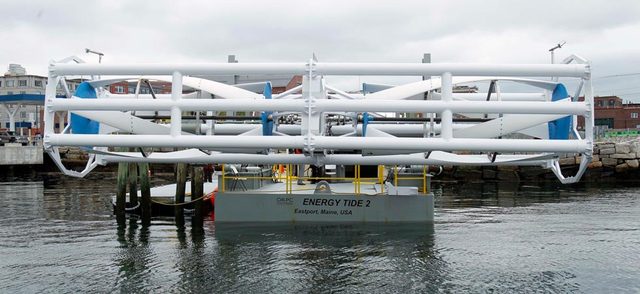
BY Tim Haeck on January 15, 2014 MyNorthwest.com
A public electric utility in Everett could be among the first in the nation to generate power from the tides.
Scientists at the University of Washington have determined that Admiralty Inlet, in Puget Sound, is an excellent place to test tidal turbines.
“Admiralty Inlet stacks up pretty well, worldwide, in terms of its actual tidal energy resource,” said Craig Collar, assistant general manager at Snohomish County Public Utility District No. 1. Currents have been clocked at 6-7 knots, he said.
The PUD is pledged to maintain carbon-free power sources. It has wind power and is exploring geo-thermal energy, as well.
“We’re highly dependent on the Bonneville Power Administration,” said Collar. “That’s a lot of eggs in one basket and it only makes sense to diversify.”
The advantage of tidal power: tides are reliable and predictable.
The disadvantage is you have to pick the right spot.
The utility wants to place two turbines, each about 20-feet in diameter, on the bottom of Admiralty Inlet, 200 feet below the surface. The more than $20 million pilot project, funded in half by the U.S. Energy Department, is at least six years in development. It’s been delayed, in part, by a challenge from a California company that owns two trans-ocean fiber optic telecommunications cables.
“The turbines, as currently proposed, are dangerously close to our cable,” said Kurt Johnson, chief financial officer of Pacific Crossing. He’s worried that turbine deployment and maintenance could damage the cables.
“Pacific Crossing is not against tidal energy, or even this specific project. All we’re really asking is that the PUD locate the turbines a safe distance from our cable.”
“In fact, we have done that,” said Collar. “This project is now several hundred feet away from their cable, so the crux of the matter is our project simply doesn’t represent any risk whatsoever to their cable.”
Collar said an environmental review by the Federal Energy Regulatory Commission (FERC), draws the same conclusion.
“The facts are they’ve got a six-inch wide lease, we’re several hundred feet away, we have a deployment accuracy of less than ten feet, we won’t use any anchors at all in the deployment operation or maintenance of these devices,” said Collar.
Tribal and environmental groups have also challenged the project out of concern for fish and orcas.
“But the truth is these turbines rotate quite slowly, more the speed that we’d visualize for a turnstile, taking several seconds just to make a single revolution,” Collar explained.
The utility is awaiting approval of a license from FERC and some state and local permits. The soonest the turbines could be deployed would be 2015.
It’s not known if tidal power will prove effective around here.
The Snohomish County PUD No.1 will hook up the turbines to the power grid but Collar said this pilot project is more about collecting data than generating electricity. If approved, the turbines will operate for three-to-five years and be removed.
